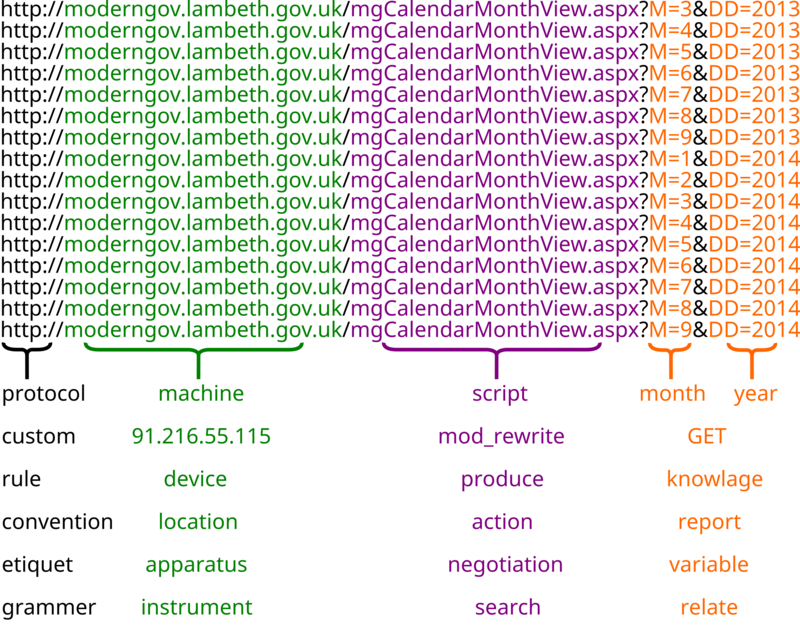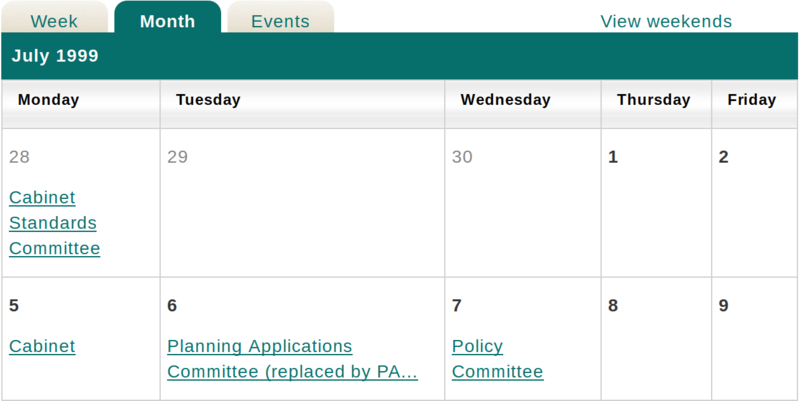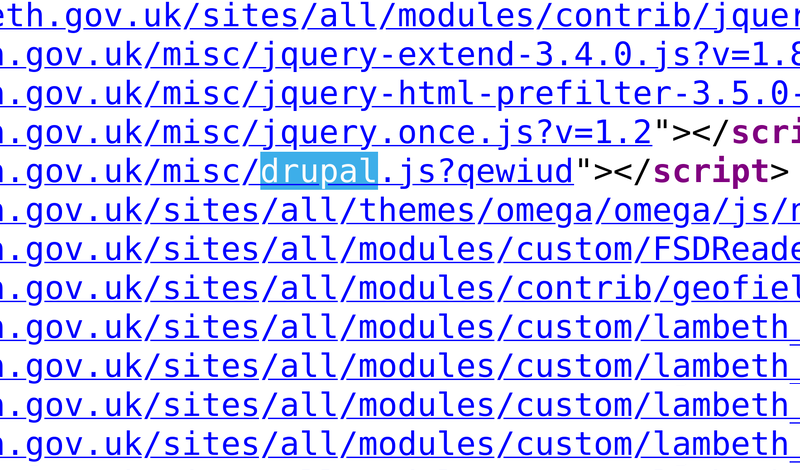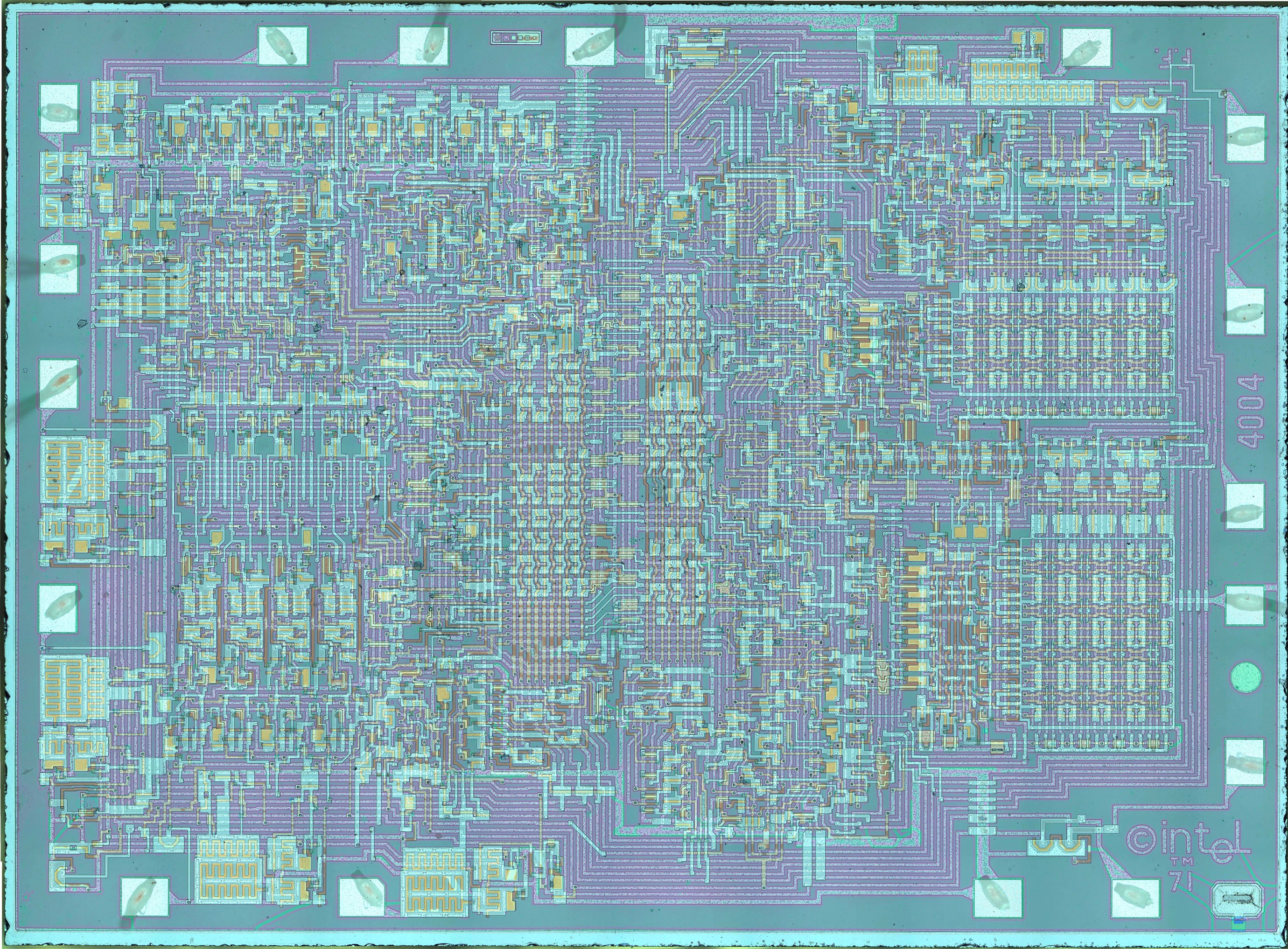modern.gov

Part of my Database (e)state research project. A combination of an artistic, activist, technical, and academic investigation of a URL used by Lambeth Borough Council, see (Keene 2022, p.106). The investigation exposes how layers of standardisation produce complexities of local government. As Andrew Barry (2001, p.67) highlights in his socio-technical analysis of the European Union, a vast array of standards, objects, and technical devices form and are formed in relation to public institutions. Lambeth Councils' calender URL is one such object which provides an interface to hidden underlying database system.

The standardised structure of Lambeth’s calendar URL allowed me to write code which automatically downloaded Lambeth’s entire corpus of decision-making documents from 1999 to March 2015. The code transformed the human gesture of clicking a link, into an automated process that generates every possible URL to display Lambeth’s calendar interface. These URLs point to over 260 HTML pages, which contained hundreds more URLs, HTML pages, and links to thousands of documents to download. After running the code over the course of a few hours the script retrieved 7 gigabytes of archived files, though it had still not finished its work. This compelled me to write more efficient code with threaded functions, which points to how technical objects generate demands that produce unintended outcomes (Simondon, 2016, p.26).

This online calendar and archive of council decisions imparts a sense of accountability, yet the effort and expertise required to interrogate decisions mean they are rarely overturned within existing democratic processes. I recognised the impossibility of reading and interpreting such a large volume of information that is organised for both a human and machine readership. As such, the truth of the archives’ existence seemed more important than its content.

I investigated the Artificial Intelligence (AI) technique of natural language processing to automatically search through the corpus of text in the hope of discovering information that might prove helpful to the @SaveCressingham campaign. Simultaneously, I was acutely aware of how my use of AI might: support my aspirations for my career by opening access to academic funding; pique the interest of art curators eager to explore new technologies; or position me within the commercial sector − I was struck by how a URL and code had instantiated more-than-technical relations between human gesture, optimisation of effort, computer hardware, HTML code, a ledger of government decision-making, and aspirations for my career.
I stopped programming.
Then created the colorful URL image as a poetic exercise to temporarily step outside of a technical mindset. In doing so I could think more broadly about how technical standardisation in a URL produces forms of government and governance. I then looked at the components of Lambeths' URL more closely:

The http:// component of the calendar URL refers to hypertext transfer protocol (HTTP) web standard. My browser employs HTTP to download and render hypertext markup Language (HTML), Cascading Style Sheets (CSS), JavaScript, image, and other file formats into the calendar interface.
A Google-search of the moderngov segment of the URL reveals: calendars with a similar URL structure on Surrey, Barnsley, and other council websites; that an organisation named Modern Mindset built Lambeth’s moderngov.lambeth.gov.uk website; and that a global corporation called Civica Group acquired Modern Mindset in 2018.
The gov.uk URL suffix identifies that the US-based Internet Corporation for Assigned Names and Numbers (ICANN) assigned permission for the UK government to use the gov.uk top-level domain name. In turn, the UK’s Digital Service will have granted Lambeth permission to use this domain.

The mgCalendarMonthView.aspx segment of the URL indicates that the website was written using a Microsoft technology called .NET involving VBSCRIPT or C# programming code. However, the HTML source code of the calendar tells me that the website was constructed with a web-framework called Drupal written in the PHP programming language. Thus an .aspx file hides layers of abstraction and complexity.
The ?M=3&DD=2013 section of the URL tells me that an underlying database powers the calendar.The ampersands delineate two keys with associated variables. The M key represents a month, and DD represents a year, both of which are passed to an SQL query that instantiates relations between tables, columns, and fields of data to return a list of meeting dates and associated documents.

I turn to the commandline which provides a text-based interface to a computer. The commandline predates graphical user interfaces and emerged in the 1960’s from computer programs such as RUNCOM and the Unix Operating System (Ritchie, 1977) which introduced ideas of multiple users, hierarchical directories, and asynchronous tasks:
host identifies that the domain name system (DNS) resolves the sub-domain moderngov.lambeth.gov.uk into the machine readable internet protocol (IP) address 91.216.55.115. The IP standard ensures that every machine connected to a computer network is assigned a unique address. Transmission control protocol (TCP) combines with IP (commonly referred to as TCP/IP) to transmit packets of data from Lambeth’s web server through multiple routers, the air-gap of my WiFi connection, onto my laptop, and into my browser software and screen.

ping reports the speed of data packets as they travel through a network.

curl reports, via the ipinfo.io website, that Lambeth’s webservers may be located in London and Dublin and that Virgin Media Limited is somehow involved in their management.

traceroute reveals that thirteen devices are involved in the transfer of data between moderngov.lambeth.gov.uk and my laptop, at this particular moment and location.

The dnsdumpster.com website revealed sixty-six sub-domains associated with the lambeth.gov.uk domain name. These domains include estateregeneration.lambeth.gov.uk, councillor.lambeth.gov.uk, revenues.lambeth.gov.uk, planning.lambeth.gov.uk, housingapplication.lambeth.gov.uk, and camp-asa-5540-1.lambeth.gov.uk − all of which point to different database-backed functions of government.

Lastly, Charles Petzolds' The Hidden Language of Computer Hardware and software (2000, p.290) points to histories of technical standards and invention such as the American Standard Code for Information Interchange (ASCII), hexadecimal codes 00h through 7Fh, 7-bit binary codes (0000000 through to 1111111), and hardware components dedicated to processing representations of text via binary flows of electricity.

This exploration of a URL exposes an evolving domain of machines, protocol, databases, organisations, and locations that predicate Lambeth’s distribution of information − from a single field of data to an entire cabinet report. These technical components are inseperable from the experience and dynamics of local and national government. Without every single one of them, Lambeth Council cannot function in the way it does. This invites speculation on how alternative protocols that might produce different kinds of government.
Network infrastructures accelerate, fragment, and multiply how and where data can be worked with and thought about − where multiple humans and machines can simultaneously access, alter, and insert data from multiple geographic locations within microseconds of each other, Munster (2013, p.77). The social and ethical implications of this are that humans and devices become detached from distant processes − in an ever changing power dynamic − which dissipates accountability, labor, knowledge, and visibility of process (Keene 2022, p.56).
Technicalities
The following commands can be experimented with in Unix-based Linux/macOS terminal applications. On windows the following commands in this linux terminal in the browser:
$ host lambeth.gov.uk
$ host moderngov.lambeth.gov.uk
$ ping moderngov.lambeth.gov.uk
$ curl ipinfo.io/91.216.55.115
$ traceroute 91.216.55.115
Use dnsdumpster.com to list sub domains.
Further exploration
What would URLS for institutions such as the NHS, local government, or national government expose? What about the URL’s of multinational corporations? And what might histories of ping, host, curl, or traceroute commandline applications reveal?